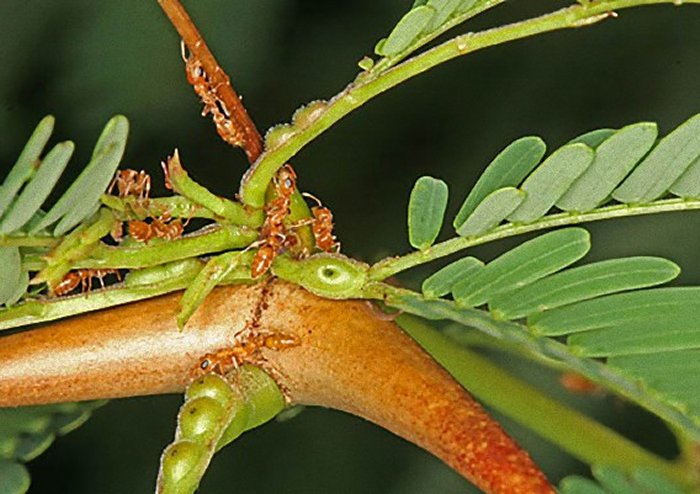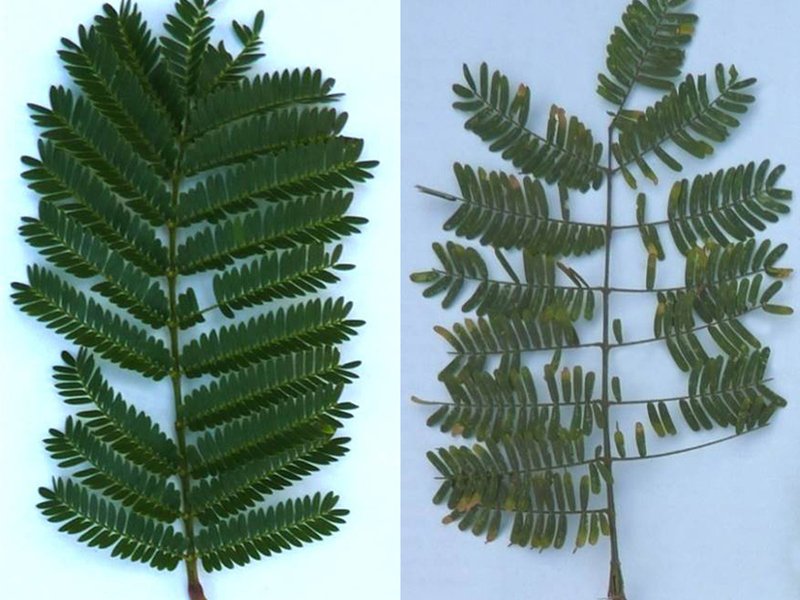Acacia Tree Uses Ants As Body Guards And Rewards Them With Shelter And Food
MessageToEagle.com – The relationship between the Acacia tree and ants is truly remarkable and highly beneficial to both parties.
The tree uses ants as body guards and in return, it rewards them with shelter and food.
The biological term “symbiosis” refers to what economists and politicians usually call a win-win situation. It’s a relationship between two partners which is beneficial to both, the Acacia tree and the ants. It’s an excellent example of how this practice works in nature.

Acacia trees are part of a large genus. There are thousands of species worldwide we can find these beautiful trees in the Southern Hemisphere and in the tropical parts of the Northern Hemisphere. Acacia tree is a member of the bean family and it’s also related to locust trees and the tamarind tree. As members of the bean family, Acacias may play host to Rhizobium bacteria which infect the rpots forming characteristic root nodules
Scientists have observed symbiotic mutualistic relationship in Acacia trees growing in Central America, and Africa.
See also:
10 Fascinating Facts About Plants
The Old Man Of Crater Lake: Mysterious Tree Trunk That Defies The Laws Of Physics
Old Tjikko Is The World’s Oldest Tree
The acacia species Acacia hindsii, which is native to tropical dry forests in Central America needs protection against herbivores and competing plants. The tree offers ants of the genus Pseudomyrmex nectar and the food bodies rich in proteins and lipids which they require and in return they defend the Acacia tree.
It should be added that some of the ants are selfish and benefit from the plant’s services without giving anything in return, such as the parasitic ant species Pseudomyrmex gracilis.
Biologists have also observed the Acacia tree and the ants sometimes become enemies. This happens when the Acacia tree cuts down the sugar amount because it no longer needs as much protection as before.

Leaves of Acacia hindsii plants colonized by mutualistic (left) or parasitic ants (right). Plants associated with the mutualistic ant species Pseudomyrmex ferrugineus are visibly healthier than their neighbours.
© MPI f. Chemical Ecology/ M. González-Teuber
If trees are fenced off to prevent large mammals from grazing on them, then there is less damage to the planets. Under these conditions, the Acacia tree cut back on the amount of sugar they provide to the ants, whose services are not as important without the herbivory occurring. Deprived of this sugar source the ants turn to another – they allow sap-sucking insects such as aphids or scale insects to attach to the plant and then get sugar exuding from the sap-suckers.
Thus, the Acacia goes from having the ants as an ally to having the ant as an enemy.
The relationship between plants, trees and animals are truly fascinated and there is still much we don’t know about our beautiful nature.
MessageToEagle.com
Expand for referencesRelated Posts
-
 95% Of All Modern Europeans Descended From The Seven Daughters Of Eve
No Comments | Dec 13, 2019
95% Of All Modern Europeans Descended From The Seven Daughters Of Eve
No Comments | Dec 13, 2019 -
 Giant Prehistoric Flying Reptile Took Off Like Bats – Study
No Comments | Aug 9, 2024
Giant Prehistoric Flying Reptile Took Off Like Bats – Study
No Comments | Aug 9, 2024 -
 The Bayeux Tapestry: One Of The Great Historical Records Of The Middle Ages
No Comments | Feb 29, 2016
The Bayeux Tapestry: One Of The Great Historical Records Of The Middle Ages
No Comments | Feb 29, 2016 -
 Unique Underwater Video: Thousands Of Red Crabs Swarming In Low-Oxygen Waters
No Comments | Apr 12, 2016
Unique Underwater Video: Thousands Of Red Crabs Swarming In Low-Oxygen Waters
No Comments | Apr 12, 2016 -
 Collision Between The Milky Way And Andromeda Galaxy
No Comments | Feb 15, 2016
Collision Between The Milky Way And Andromeda Galaxy
No Comments | Feb 15, 2016 -
 Mysteries Of The Yellow Emperor – The ‘Son Of Heaven’ From Regulus
No Comments | May 10, 2014
Mysteries Of The Yellow Emperor – The ‘Son Of Heaven’ From Regulus
No Comments | May 10, 2014 -
 4,000-Year-Old Termite Mounds Discovered In Brazil Are Visible From Space
No Comments | Nov 21, 2018
4,000-Year-Old Termite Mounds Discovered In Brazil Are Visible From Space
No Comments | Nov 21, 2018 -
 Chicken-Sized Dino With Impressive Stiff Ribbons Projecting Out And Back
No Comments | Dec 17, 2020
Chicken-Sized Dino With Impressive Stiff Ribbons Projecting Out And Back
No Comments | Dec 17, 2020 -
 5,000-Year-Old Carrots Were Once Purple, White, Black And Red
No Comments | Feb 21, 2017
5,000-Year-Old Carrots Were Once Purple, White, Black And Red
No Comments | Feb 21, 2017 -
 Merkhet – An Ancient Egyptian Timekeeping Instrument
No Comments | Jan 15, 2016
Merkhet – An Ancient Egyptian Timekeeping Instrument
No Comments | Jan 15, 2016
